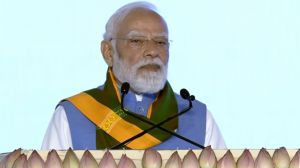Stuck in the ruins
In 1999 UNESCO awarded it the ‘danger’ status, prompting various agencies to launch restoration schemes. None has managed to pull Hampi out of the ruins

IN the last few years, the world’s conservationists, archaeologists, historians, even poets have deplored the neglect of the magnificent 24-sq km Hampi Heritage site of the glorious 14th century Vijayanagara Empire in Karnataka. Yet, the tragic-comedy of restoring the site to make it a world-class experience continues to unfold, with policies and counter programmes, pulling and pushing the concerned groups in different directions.
So, it was with some trepidation that the Union T&C minister Ambica Soni, led a delegation of her officials, from joint-secretaries to ASI DG, along with UNESCO Director, Minja Yang, to Hampi, to make a thorough and conclusive assessment of the present state of affairs at the medieval site.
At the heart of the matter is the dreaded ‘danger’ status awarded by UNESCO to Hampi in 1999, after the premier UN agency watched with alarm the unfettered and unfocussed development of the world heritage site, and the agency is unconvinced it has to be revoked as yet.
The two bridges (pedestrian bridge has now been abandoned) across the Tungabhadra River, construction of modern buildings around the monument, large-scale encroachments, all within the core heritage area, are under scrutiny if Hampi has to regain its WHS status and remain a beneficiary of UNESCO’s conservation expertise and the World Bank’s funds.
SPEEDING past sugarcane fields along Hospet, the closest rail destination for Hampi, some of the absurdities of a skewed heritage development policy are quickly revealed. The first stop is a massive, concrete, incomplete Tourist Information Centre, built by former T&C minister Jagmohan, now a bone of contention among various groups.
Standing tall and grey, the centre is self-conscious under Hampi’s dominating landscape of looming granite boulders, hills and gigantic rocks. Both the UNESCO Save Hampi Trust and the Citizen’s Forum, want the centre relocated, the HUDCO (construction company), ASI and the district authorities want it to stay, or at least re-modified for another purpose, say a pilgrim guest house-cum-shopping complex. Rs 1 crore has already been sunk into it and the HUDCO engineer is adamant when he says, ‘‘We went ahead with this plan only after UNESCO gave us the go-ahead.’’
Yang shakes her head vigorously, ‘‘There must be some misunderstanding as we would never have commissioned a building in this location. We are very clear the location is bad as it will lead to urbanisation of this extremely sensitive core heritage area.’’ Yang recommends the centre be moved to either Kamalapura or Kadirampura, areas now identified for town extension and economic activity.
If this confounds onlookers, there is complete bedlam in the next stop—the famed, historical bazaar street in the Virupaksha Temple complex, barely a kilometre away. The minister is welcomed by protesting shopkeepers shouting slogans against their proposed eviction from the site to Kamalapura. The shops that line the street leading to the temple door sell mainly temple offerings, clothes and other knick-knacks. Says Govindappa, another shopkeeper, ‘‘These monuments were maintained and protected over centuries only because of us, if the government says we have encroached land, we are willing to shift behind the mandappas (the line of ancient shops).’’
The Hampi (WH) Area Development Authority Act 2002, was enacted to create an exclusive body to prevent uncontrolled development and commercial exploitation of the area. Says Arvind Srivastav, Dy Commissioner, Bellary, and chairman, ‘‘We will make a blueprint for Hampi’s management as soon as the Integrated Management Plan drafted in Delhi is sent to us.’’
Says Soni later, ‘‘There are differences of opinion on the management of the site but we have great infrastructure development plans to make Hampi a world tourist destination. We want to attract boutique hotels, build an airfield, design the site with pit stops for refreshments, artifacts and books, and attract the high-spender, even while incorporating modern environment-friendly methods like solid waste management, Euro III buses, solar lighting and the like.’’
She adds, ‘‘The ASI has now decided to acquire 234 acres at a cost of Rs 10 crores, which will come under the jurisdiction of the Authority. Once the master plan is submitted to the Authority, we can come with a policy which envisages conservation as well as infrastructure development for the local community. No conservation is complete if it does not include local stakeholders.’’
Soni is referring to the contentious suspension bridge which links Hampi to Anegundi, the first capital of the Vijayanagara empire—locals need it desperately. UNESCO agrees the bridge is required, except it should have been located elsewhere. ASI DG Babu Rajeev implores, ‘‘UNESCO’s worry that heavy load traffic will endanger the fragile area has been taken care of and the by-pass road has been shifted away from the site.’’
There are other issues too. Local guides are pleading for exclusive rights and better remuneration (from a measly Rs 400 to Rs 2000 per month), even the local MLA, HR Gaviappa, makes an impressive presentation to convert eight surrounding villages into heritage villages.
And so, Hampi with all its grandeur, awaits the pilgrim and tourist, even as its latter-day guardians wring their hands for the best solution.


- 01
- 02
- 03
- 04
- 05





























